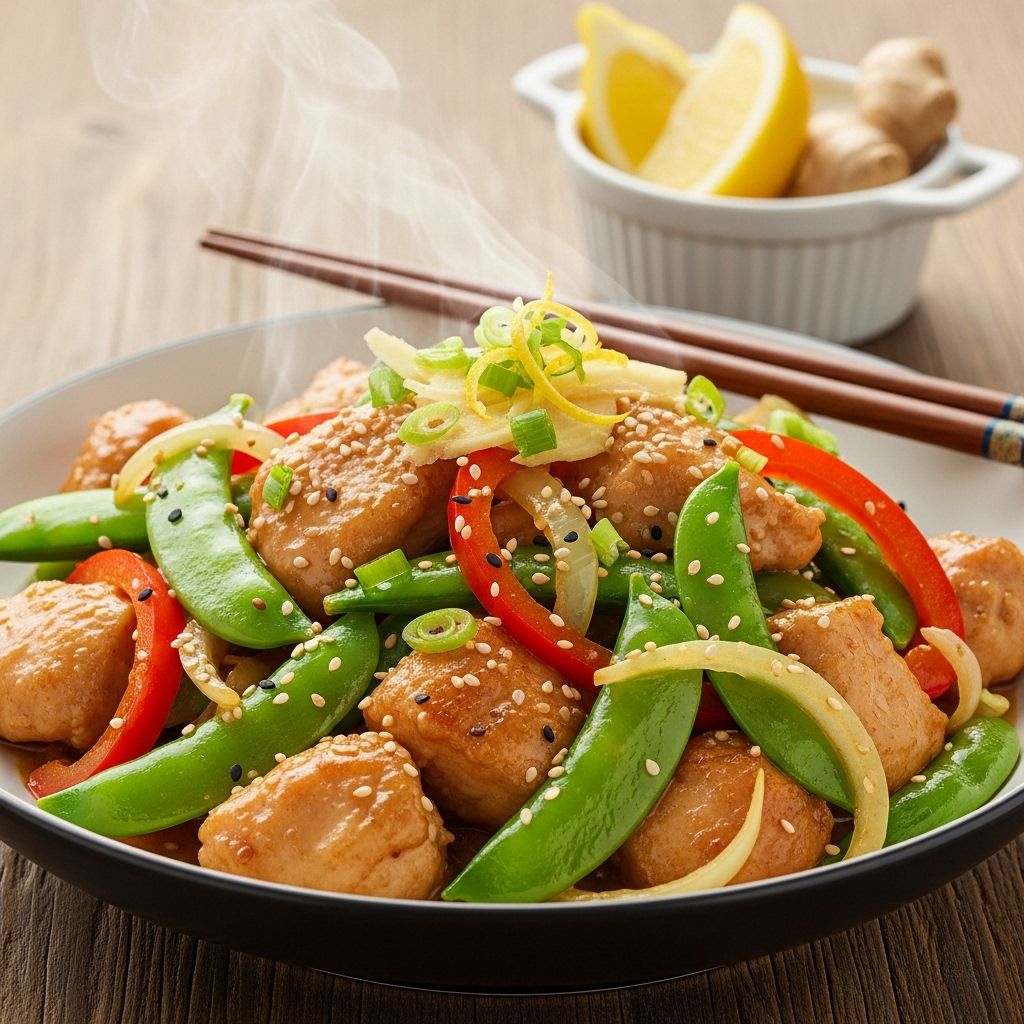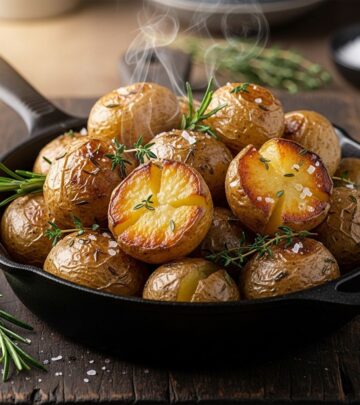Stir-Fried Velvet Chicken with Snap Peas and Lemon Ginger Sauce: Technique and Recipe
A simple marinating trick locks in moisture for ultra-tender results every time.

Stir-Fried Velvet Chicken with Snap Peas and Lemon Ginger Sauce
Chinese stir-fries are celebrated for their crisp vegetables and tender, succulent meats. This article explores velveting—the classic technique for producing silky chicken in restaurants—and demonstrates how to make Stir-Fried Velvet Chicken with Snap Peas and Lemon Ginger Sauce using home-friendly methods.
Why Velveting Matters in Stir-Frying
Achieving restaurant-level texture in stir-fried chicken rests on a precise pre-cooking method: velveting. Velveting involves marinating chicken with a combination of egg white, cornstarch, wine, and aromatics, then briefly passing it through hot oil or water. This essential technique yields chicken with a moist interior and a delicate, slippery coating, preventing dryness during high-heat cooking.
Velveting is far more impactful on finished texture and flavor than stove power or specialty woks.
Recipe Overview
- Cuisine: Chinese-American
- Course: Main
- Preparation Time: 25 minutes
- Cooking Time: 10 minutes
- Total Time: ~35 minutes
- Servings: 4
Ingredients
For Velveting Chicken
- 1 pound (450g) boneless, skinless chicken breasts or thighs, thinly sliced against the grain
- 1 large egg white
- 2 teaspoons cornstarch
- 1 tablespoon Shaoxing wine or dry sherry
- 1/2 teaspoon kosher salt
- 1 tablespoon neutral oil (such as canola or vegetable oil)
For the Stir-Fry
- 2 tablespoons neutral oil (for stir-frying)
- 8 ounces (225g) fresh snap peas, trimmed
- 1 tablespoon minced fresh ginger
- 2 teaspoons minced fresh garlic
- 3 scallions, sliced on a bias (white and green parts separated)
For Lemon-Ginger Sauce
- 2 tablespoons freshly squeezed lemon juice
- 1 tablespoon soy sauce
- 1 tablespoon Shaoxing wine or dry sherry
- 2 teaspoons sugar
- 1/2 cup low-sodium chicken stock
- 1 teaspoon cornstarch
Step-by-Step Instructions
1. Slice and Marinate the Chicken
- Slice chicken into 3mm thick sheets, cutting against the grain for maximum tenderness.
- In a medium bowl, whisk together egg white, cornstarch, wine, and salt until smooth.
- Add sliced chicken, coating thoroughly. Marinate for 30 minutes at room temperature.
2. Velvet the Chicken
- Heat 2 cups oil (or bring a pot of water to a gentle simmer) to 150°C (300°F).
- Working in batches, add chicken and gently stir. Cook for 30–45 seconds—until the meat turns opaque but is not browned.
- Remove chicken with a strainer or slotted spoon; drain thoroughly on a plate lined with paper towels.
- This step creates the signature velvet texture by forming a thin, resilient coating that insulates the meat from intense stir-fry heat.
3. Prepare Lemon-Ginger Sauce
- Whisk lemon juice, soy sauce, wine, sugar, stock, and cornstarch in a small bowl until fully dissolved.
- This sauce delivers brightness and gentle acidity to balance the succulent velvet chicken and fresh vegetables.
4. Stir-Fry the Vegetables
- In a wok or large skillet over high heat, add 2 tablespoons neutral oil.
- When oil is shimmering, add minced ginger, garlic, and the white part of scallions.
- Stir-fry for 30 seconds until fragrant.
- Add snap peas and toss rapidly for 1–2 minutes. Vegetables should remain crisp-tender and vivid green.
5. Combine Chicken and Sauce
- Return velveted chicken to the wok. Pour in lemon-ginger sauce and toss to coat.
- Cook for 1–2 minutes, allowing the sauce to thicken and coat chicken and peas evenly.
- Stir in scallion greens.
- Remove from heat and serve immediately.
Technical Notes: Understanding Velveting
- Texture Transformation: Velveting with egg white and cornstarch forms a delicate shield, locking in the meat’s moisture and enhancing tenderness.
- Oil or Water Velveting: Professional kitchens usually use oil for velveting, but poaching in lightly simmering water (“water-velveting”) is a lighter alternative for home cooks.
- Marinade Science: Shaoxing wine or sherry provides subtle aroma; salt and cornstarch both tenderize and protect; neutral-flavored oil reduces sticking and promotes a silky finish.
Why Does Restaurant Chicken Taste Different?
Most Western stir-fries omit velveting, resulting in chicken that’s firm or dry. Chinese restaurants reliably use this method, resulting in velvet-soft, slippery chicken with extraordinary juiciness. Velveting is foundational to dishes like Chicken and Broccoli, Moo Goo Gai Pan, and many classic Cantonese stir-fries.
Ingredient Table: Chicken Velveting Marinade
| Ingredient | Purpose |
|---|---|
| Egg white | Creates smooth, silky coating |
| Cornstarch | Forms a protective barrier; tenderizes meat |
| Shaoxing wine | Adds subtle aroma and flavor |
| Salt | Tenderizes via rapid brining |
| Oil | Reduces sticking; enhances smoothness |
Tips for Perfect Velvet Chicken at Home
- Slice Evenly: Uniform slices ensure consistent cooking and texture.
- Don’t Overcook: Remove chicken immediately once opaque; longer cooking will toughen or dry out the meat.
- Use Fresh Ingredients: Snap peas and ginger should be crisp and aromatic for optimal results.
- High Heat Matters: Stir-fry over high flame for best flavor development, but rely on the velvet coating to shield the chicken from harsh temperatures.
- Customize Vegetables: Substitute other vibrant vegetables—such as snow peas, asparagus, or baby corn—according to personal taste.
Frequently Asked Questions (FAQs)
Q: Can I velvet chicken without oil?
A: Yes. The “water-velveting” method uses simmering water instead of oil for a lighter result. The texture is equally silky but may be less glossy.
Q: What if I don’t have Shaoxing wine?
A: Substitute dry sherry for the closest flavor profile. If unavailable, dry white wine offers a neutral alternative.
Q: Can velveting be used for other meats?
A: Absolutely. Velveting works for pork, beef (with added water and oyster sauce), shrimp, fish, and even tofu—though marinade ratios may shift based on the protein.
Q: Why do I need cornstarch and egg white?
A: Cornstarch creates a thin shield against heat, while egg white contributes to the silky, slipperiness associated with restaurant stir-fries.
Q: My chicken sticks to the pan. Help?
A: Thoroughly velveting and draining the chicken before stir-frying minimizes sticking. Use adequate oil and a well-heated pan. Water-velveting is recommended if pan-sticking is a persistent issue.
Q: How do I keep vegetables crisp?
A: Stir-fry vegetables rapidly over high heat, remove once vibrant, and avoid overcooking.
Serving Suggestions and Variations
- Rice Bowl: Serve velvet chicken and snap peas over steamed jasmine or short-grain rice.
- Noodles: Toss with thin egg noodles or rice noodles, using extra sauce to coat.
- Vegetarian: Substitute chicken with firm tofu, using the water-velveting technique and gentle handling.
- Spicy Kick: Add sliced fresh chili or sprinkle with chili oil before serving.
- Make Ahead: Velvet chicken in advance; store in the refrigerator up to 24 hours before stir-frying.
A Closer Look: The Science of Velveting
The combined effect of alkalinity from egg white and tenderizing agents (like wine and salt) loosen muscle protein bonds—the result is a slippery, almost ethereal mouthfeel. Cornstarch forms a micro-layer that insulates the meat, permitting ultra-brief cooking while locking in moisture. This is why velveting, and not simply high-heat stir-frying, produces the coveted ‘restaurant’ texture.
Conclusion: Elevating Stir-Fries to Restaurant Quality
Once mastered, velveting empowers home cooks to create stir-fried chicken dishes rivaling the best Chinese restaurants. By leveraging a simple marinade and a brief pass through oil or water, you transform ordinary chicken into delicately tender, juicy, and flavorful morsels. Combined with crisp snap peas and a lively lemon-ginger sauce, this technique unlocks a world of vibrant stir-fry possibilities.
SEO Optimization: Further Reading and Resources
- Learn more about velveting techniques from Chinese cooking experts.
- Explore variations for beef, pork, and seafood in stir-fries.
- Discover additional stir-fry recipes featuring seasonal vegetables and sauces.
More Frequently Asked Questions
Q: Is velveting necessary for tofu or seafood?
A: Yes—velveting is highly recommended for tofu and seafood (like shrimp), as it prevents overcooking and improves texture.
Q: How long does the velveting process take?
A: Marinating should last at least 30 minutes; the oil- or water-dip takes less than a minute per batch.
Q: Is baking soda required for velveting?
A: While some recipes use baking soda as an alkaline tenderizer, it’s not essential for chicken. Egg white and a small amount of wine are sufficient for classic velveting.
Read full bio of Sneha Tete












